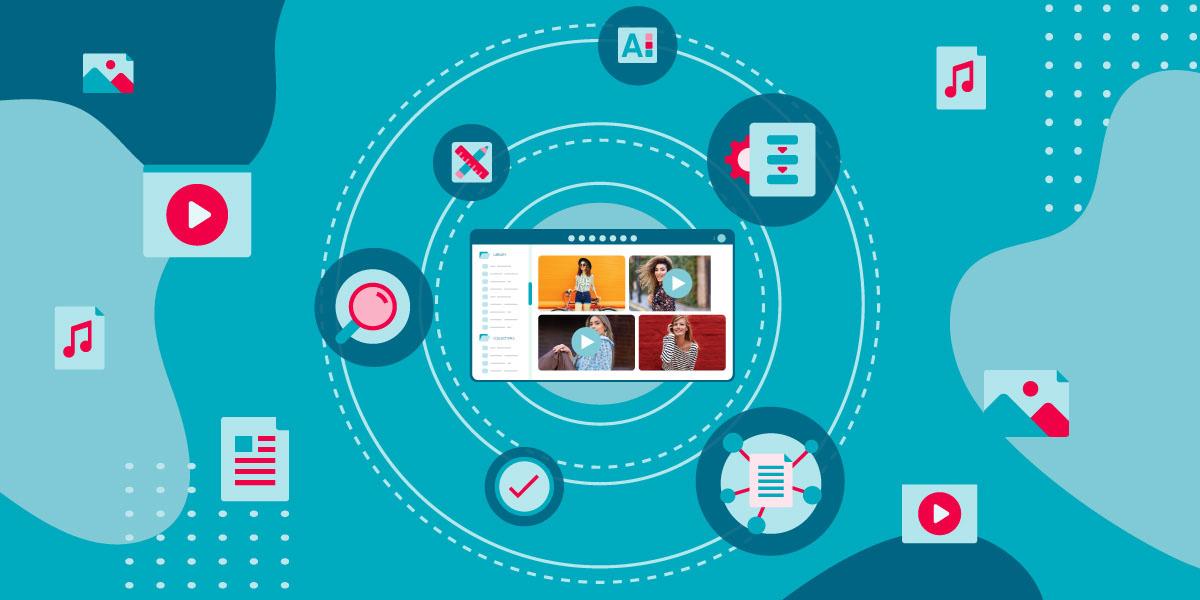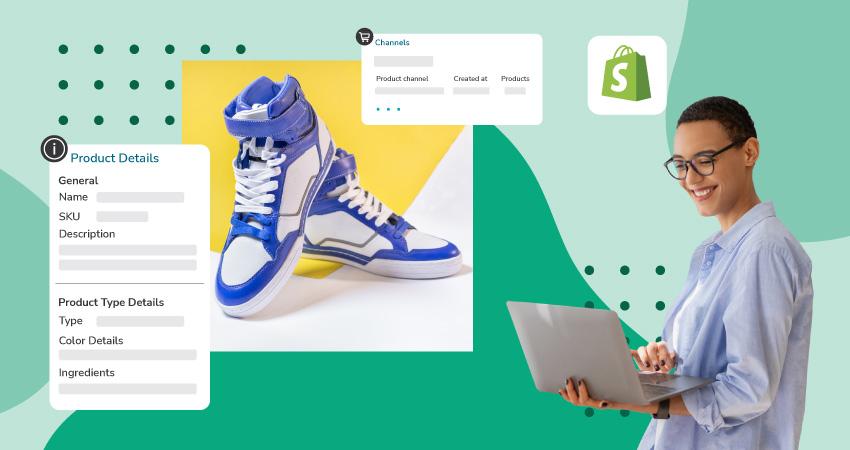Mastering digital content management: Platforms, techniques, and tools for digital marketing

Key highlights
- Digital content management: The structured process of organizing, storing, and distributing digital assets so teams can find, share, and use them efficiently.
- Top digital content management benefits: Increased speed to market, strengthened brand consistency, improved collaboration, and boosted content ROI.
- Top digital content management platforms: Leading options for a digital content management system include DAM, PIM, CMS, MAM, ECM, and DXP solutions.
- Top use cases: Supports e-commerce, marketing campaigns, sales enablement, internal communications, partner collaboration, and omnichannel content delivery.
What is digital content management?
Digital content management (DCM) is the practice of organizing, storing, and distributing all forms of digital media, such as images, videos, documents, product data, and more.
For modern enterprises and growing brands, managing digital content means creating processes that keep every file current, accurate, and aligned with brand standards.
Digital media content management focuses specifically on rich media like video and photography.
A digital content management system (DCMS) is the software platform that powers these workflows, enabling teams to search, version, approve, and publish assets.
Why content management in digital marketing matters
Speed to market
A centralized digital marketing content management approach means campaign assets are reviewed, approved, and ready to publish much faster. Teams avoid email bottlenecks and scattered file shares, enabling them to launch timely campaigns that match trends and seasonal opportunities. With a streamlined process, brands can focus on messaging and creative impact rather than chasing down missing files.
Omnichannel delivery
Consumers connect with brands through social media, e-commerce marketplaces, and in-store displays. Managing assets for omnichannel delivery ensures every channel gets the correct version, format, and resolution. Strong digital marketing content management also prevents off-brand or outdated materials from slipping through, allowing marketers to maintain a unified voice and look across e-commerce retail touchpoints.
Brand consistency
A robust content management system in digital marketing gives teams easy access to approved assets and guidelines, reducing the risk of off-brand visuals or messaging. A digital content management system ensures that every interaction maintains brand consistency, whether a social ad, trade show banner, or blog post.
Efficiency
Time spent searching for files or recreating assets drains marketing efficiency. By implementing centralized digital marketing content management, teams spend more time creating and optimizing campaigns in a streamlined workflow, not sorting through folders. Structured metadata and search functions also mean anyone can contribute faster.
Digital content management strategy and techniques
Metadata management and taxonomy
Effective metadata management organizes content so it’s instantly searchable. Creating a clear taxonomy — categories, tags, naming conventions — ensures quick asset discovery, no matter how large your library grows. Also, a robust metadata structure supports better analytics and governance.
Auto-tagging
AI-powered auto-tagging speeds up content classification by generating and adding descriptive tags during asset ingestion, keeping your collection organized. When paired with a broader digital content management strategy and robust folder structure, auto-tagging makes it easy for teams to find content, encouraging asset reuse.
Reuse frameworks
High-performing assets should never be “one and done.” You can maximize ROI and maintain consistent messaging by storing your content in a searchable library and using frameworks for repurposing content, such as resizing, reformatting, or re-theming.
Governance models
Governance using a digital content management system ensures the right people can access and modify the right assets. Clear permissions, roles, and approval workflows reduce content misuse risk and maintain compliance. A DCM system also supports collaboration across distributed teams, aligning with content scaling strategies.
Workflow automation
Automation tools can handle repetitive tasks like routing approvals, notifying stakeholders, and publishing assets to connected channels. Workflow automation frees teams to focus on creative and strategic work while maintaining speed and accuracy.
What are the top digital content management systems, platforms, and tools?
Digital asset management (DAM) system

A digital asset management system like Canto is a digital content management platform designed to centralize, organize, and distribute all digital and brand assets, improving content ROI and speed to market. DAM software is essential for brands managing high volumes of media across teams and channels.
Top features:
- Self-service: Centralized and visual platform
- AI tools: Intelligent search, auto-tagging and captioning, AI facial recognition, and text extraction
- Brand management: Version control, approval workflows, style guides, and brand templates
- Collaboration tools: Workspaces, DAM workflows, and tool integrations
- Risk management: Digital rights management, expiration dates, granular user permissions
- Delivery automation: Channel automation, brand portals, share links, and asset transformation tools
Product information management (PIM) platform
A PIM system stores and manages detailed product data — product descriptions, specs, and pricing — ensuring consistency across marketplaces and channels.
Top features:
- Centralized product information database
- Multichannel syndication
- Data validation and governance

Content management system (Web CMS & headless)
A CMS manages website content, while a headless CMS separates the backend from the presentation (frontend) layer.
Top features:
- Web content editing tools
- Template and theme management
- Editorial workflows
Or, take a closer look at DAM vs. CMS.
Document management system (DMS)
A DMS focuses on storing, tracking, and securing business documents, ensuring compliance and easy retrieval.
Top features:
- Version tracking
- Access controls
- Searchable archives
Enterprise content management (ECM) platform
ECM platforms combine DAM, DMS, workflows, and compliance features for large-scale, regulated environments.
Top features:
- Enterprise-wide content control
- Compliance management
- Workflow integration
You can also dive deeper with a comparison between CMS vs. ECM.
Social media asset management tool
Social media asset management tools allow teams to schedule posts, monitor engagement, and manage multiple accounts from one place.
Top features:
- Cross-platform scheduling
- Analytics dashboards
- Social listening
Media asset management (MAM) system
Media asset management systems help teams manage vast video libraries, with advanced capabilities for broadcasters and studios.
Top features:
- Video transcoding
- Time-based metadata
- Streaming capabilities
Take a closer look at DAM vs. MAM.
Knowledge management platform
Knowledge management platforms capture and share institutional knowledge, improve onboarding, and reduce duplicated work.
Top features:
- Searchable knowledge base
- Collaboration spaces
- Document linking
Digital experience platform (DXP)
A DXP combines CMS, analytics, and personalization tools to orchestrate consistent customer experiences across touchpoints.
Top features:
- Experience orchestration
- Content personalization
- Integration with marketing tools
Common digital content management channels and use cases
Manage digital content on Amazon
For brands selling on Amazon, managing product listings, media assets, and enhanced brand content is a high-stakes process. Teams must ensure that every image meets Amazon’s technical requirements, every product description is accurate, and all rich media aligns with brand standards. Using product information management and digital asset management systems (or unified DAM+PIM solutions), marketers can push product information and content updates directly to Amazon listings without manually re-uploading assets, saving hours each week and reducing errors. Every potential customer will see consistent, up-to-date content that reinforces brand trust.

Shopify for direct-to-consumer (DTC)
E-commerce teams running their storefronts on Shopify rely heavily on a central asset library to maintain a consistent brand look. Teams can quickly update product photos, banners, and seasonal imagery by connecting a DAM platform like Canto to Shopify without touching individual product pages. A streamlined approach hastens content updates and ensures every asset used in your DTC shop meets quality and branding standards.
Digital content management for sales
A digital content management platform like DAM software centralizes and organizes all sales materials, ensuring that these materials are always current and accessible from anywhere. Instead of sending large email attachments post-call, reps can share secure links to the right content in real time. A DAM system shortens sales cycles and reinforces brand consistency across customer touchpoints.
Dive further into DAM solutions for sales teams.
Internal communications
Internal communications teams manage company-wide announcements, training materials, and culture-focused content. A DAM system is the single source of truth for these materials, ensuring every employee receives accurate, approved communications. Centralized internal communications avoid confusion from outdated files circulating via email or chat.
Brand hubs
A brand hub is a curated portal that gives internal and external stakeholders — like agencies, freelancers, or distributors — access to brand guidelines, logos, templates, and approved imagery. With centralized control, marketing managers can ensure that partners always have the latest brand assets, preventing inconsistencies and protecting brand equity.
Partner portals
For businesses that work with resellers, affiliates, or distributors, a partner portal powered by a DAM platform allows external partners to pull approved assets and marketing kits on demand. Portals eliminate time-consuming manual distribution and ensure brand compliance across a broader ecosystem of content publishers.
Best practices for implementing and managing digital content
Content lifecycle
Managing the full content lifecycle — from creation and review to content distribution, archiving, and eventual deletion — is essential for long-term operational efficiency. DAM software provides structured workflows, storage, and retrieval for every stage of content lifecycle management.
Editorial calendar
An editorial calendar aligns content creation with business goals and campaign timelines. Within a DAM system, teams can link calendar planning with asset storage, making it easy to connect scheduled content directly to the creative files they need.
Accessibility
Content must be easy to read for those with disabilities and compliant with legal requirements. DAM systems support accessibility by storing accessible versions of files and maintaining metadata that flags compliance.
Version control
Without version control, teams risk using outdated or incorrect content. A DAM platform tracks asset changes, stores previous versions, and ensures usage of only the most recent approved asset.
SLAs and RACI
Service level agreements (SLAs) define expectations, while RACI matrices clarify roles. Digital content management platforms such as DAM software help uphold these frameworks by providing visibility into asset status and ownership, making governance enforceable.
Risk management and rights management
Tracking usage rights is critical for avoiding legal issues. DAM software’s digital rights management tools can store licensing information, such as terms and conditions and usage restrictions, and apply watermarks to sensitive files.
Governance and approvals
Centralized workflow management ensures that only approved assets are published. A DAM platform enables automated approval workflows, reducing delays while maintaining compliance.
Measurement and optimization in digital marketing
Content engagement
Content engagement measures how audiences interact with your content — views, clicks, likes, shares, and comments. Higher engagement signals that content is relevant and valuable. Engagement metrics help teams identify assets to reuse or adapt for other campaigns.
Lead conversion
Lead conversion tracks the percentage of prospects who take a desired action after interacting with your content, such as filling out a form or requesting a demo. Understanding conversion rates helps marketing managers refine targeting and messaging.
Asset reuse rate
Asset reuse rate shows how often an asset is repurposed across campaigns or channels. A high reuse rate reflects strong content, efficient processes and workflows, and increased content value.
Time-to-publish
Time-to-publish measures the duration between asset creation and its first use. Reducing time-to-publish boosts agility, allowing teams to respond faster to market opportunities.
ROI
Return on investment in content management compares the revenue or value generated by assets to the costs of creating, storing, and managing them.
Digital content management pitfalls
Siloed assets
Scattered assets across personal drives, email threads, and disconnected tools waste time searching and often duplicate work. A DAM platform unites your marketing stack, improving collaboration and speed.
Unmanaged metadata
Without metadata governance, assets become invisible in large libraries. Poor tagging means teams can’t find or trust the files they have. DAM platforms enforce metadata standards and provide intelligent search, improving content organization and discovery.
Outdated tools
Legacy systems or basic file storage tools can’t handle the complexity of today’s digital content management systems. Outdated tools slow workflows, limit visibility, and lack the integrations modern teams need — issues solved by upgrading to a scalable DCM system like a DAM platform.
Canto PIM is the leader in digital content management
Growing teams need to think ahead when investing in the best digital content management system for their organization. If your team manages digital files via cloud storage and product information with spreadsheets, it’s time to level up.
Canto PIM is an industry-leading solution that unites digital content and product information inside one platform. It unifies product, marketing, creative, e-commerce, and sales teams in one workflow, streamlining content production while maintaining brand consistency.

Digital content management frequently asked questions
What is the meaning of digital content management?
Digital content management is a methodology for organizing, storing, and distributing digital assets for simplified discover and access.
What is digital marketing content management?
Digital marketing content management is the strategic organization and delivery of content specifically for digital marketing purposes — ensuring campaigns have timely, brand-compliant assets.
What is a digital content management system?
A digital content management system is a solution for storing, organizing, and delivering digital assets like images, videos, and documents.
What is digital content management software?
Applications like DAM, PIM, and CMS are digital content management software that enable content storage, organization, and distribution.
What is a digital content manager?
A digital content manager oversees asset governance, workflows, and performance across the content lifecycle.
What are the different types of digital content management systems?
A few common types of digital content management systems include digital asset management (DAM), product information management (PIM), and content management systems (CMS).
What is digital content management vs DXP?
DCM organizes and delivers assets, while DXP focuses on personalized digital experiences.
How do you manage digital content for Amazon listings?
The best method to manage Amazon listings is to use a DAM and PIM solution like Canto PIM to keep product data and visuals accurate and on brand.
Which digital content management systems are best for digital marketing?
Digital asset management software, headless CMS, and social media management tools are top choices for fast-moving digital marketing teams.
What tools support digital collaboration and digital marketing content management?
Digital content management systems like DAM platforms support real-time commenting, version control, and automated workflows.